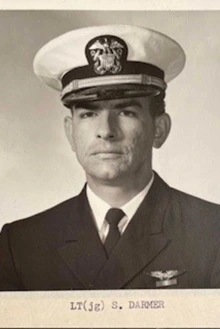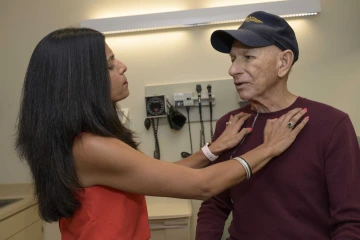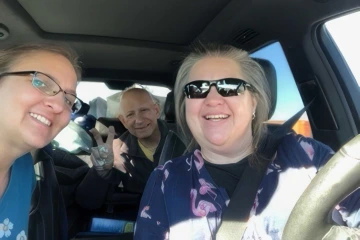Clinical trial gives cancer patient the gift of time
Silver Darmer gained years of family time thanks to the University of Arizona Cancer Center and a combination therapy that pairs immunotherapy with targeted chemotherapy.
Silver Darmer has always navigated his way through tough conditions, even in the isolated and inhospitable environment of Antarctica.

Silver Darmer became a naval flight officer in 1968 after graduating from the University of Arizona with a bachelor’s degree in chemistry.
Photo courtesy of Rebecca Melland
“We had to learn to find our way using the sun, moon and stars,” said Darmer, a Navy veteran and former naval flight officer for Operation Deep Freeze.
Operation Deep Freeze began in the 1950s as a joint military mission supporting researchers on Antarctica. Silver arrived in the 1960s. His job was to get scientists where they needed to go and back safely.
“My only point of reference was usually the sun, and I thought it was a fantastic experience. I can’t describe what it was like to see the glaciers up close,” he said. “I still don’t wear a watch, because I can tell the time by the sun’s position in the sky.”
Much of Darmer’s military career was spent on Earth’s last continental frontier, and he is now navigating a new frontier. For the last seven years, the 79-year-old has been not only surviving but thriving with pancreatic cancer. He credits his participation in a clinical trial designed by researchers at the University of Arizona Health Sciences.
“My attitude was, I have a little problem and I have to stay ahead of it. I did not want to let cancer determine the story of my life,” Darmer said.
Life before cancer
Darmer was born in Mexico and immigrated to Tucson as a young child. He can remember his family struggling to make ends meet.
“The focus was on our poverty,” he said. “We all had to find work. I would chop wood and run errands for people. We would give the money to my mother, and that is how we survived.”
Working odd jobs and having to learn English didn’t deter Darmer, who excelled in his studies. In high school, he was awarded a scholarship to the University of Arizona, where he completed a Bachelor of Science in Chemistry. Eventually, he returned to the university for a master’s in soils and water science and a Master of Business Administration.

Rachna Shroff, MD, examines Darmer, who receives regular medical check-ups and biopsies to evaluate his health and cancer status.
Photo by Kris Hanning, UArizona Health Sciences Office of Communications
“I would never have been able to afford college if not for that scholarship,” Darmer said. “I was always interested in science, and chemistry seemed like a profession where there would always be a guaranteed job. Later, I became interested in the business side of things as well.”
Before he completed his bachelor’s degree, Darmer met with a Navy recruiter on campus.
“He asked if I’d be interested in flying airplanes, and I thought that sounded like something I would enjoy. They allowed me to finish my degree before signing up,” Darmer said. “It turned out I couldn’t be a pilot because my vision wasn’t perfect, but that is when I became a naval flight officer and started learning about navigation.”
Darmer considered his assignment to Antarctica, instead of Vietnam, a stroke of good fortune. His luck continued even after the deployment ended. Just days after he returned home to be honorably discharged, the plane he served on experienced a mechanical failure and crashed.
“No one was injured thank goodness, but 10 men had to live in survival shelters until they were rescued,” he said.
As life went on, Darmer married, twice, and welcomed four daughters into the world. All was well until the summer of 2016, when he was diagnosed with pancreatic cancer.
“It was bizarre,” he said. “You hear your whole life how bad cancer is, but I felt fine, like there couldn’t be anything wrong. I basically went into the doctor’s office for a routine appointment, and at the end of it they told me they suspected pancreatic cancer.”
Defying the odds
Doctors at a Veterans Affairs clinic treated Darmer with chemotherapy and radiation before performing a complex operation known as Whipple surgery to remove the cancerous tumors. After surgery, Darmer received chemotherapy for three months to kill any lingering cancer cells.
For a while, the treatments appeared to work. But then, two years later, the cancer returned. This time it had metastasized to his lungs. Darmer was diagnosed with Stage 4 metastatic pancreatic cancer, which has a five-year survival rate of around 3%, according to the National Institutes of Health National Cancer Institute.
“Before I met Silver, he was being treated with the standard chemotherapy cocktails,” said Rachna Shroff, MD, interim clinical affairs director at the UArizona Cancer Center and professor and chief of the Division of Hematology and Oncology in the Department of Medicine at the UArizona College of Medicine – Tucson. “These therapies have been proven to be relatively effective in some cancers, but it is extremely difficult to treat Stage 4 pancreatic cancer. Unfortunately for Silver, the cancer was mutating and seemed to be outsmarting the drugs being thrown at it.”
With conventional treatments no longer working, Darmer was ready to try something new. He met with Shroff in October 2022 to discuss becoming a participant in one of her clinical trials.
Combining treatments
The most common treatments for cancer include surgery, radiation chemotherapy, the latter of which uses chemicals to kill fast-growing cancer cells and stop them from multiplying.
One of the newest methods being used to treat cancer is immunotherapy, which activates the immune system to fight diseases. One way the immune system protects the body is by activating T-cells, which are a type of white blood cell that fight germs and foreign substances. Certain proteins, called checkpoints, act as a “brake” to prevent T-cells from activating and killing cancer cells. Checkpoint inhibitors are immunotherapy drugs that “release the brake” on the immune system and T-cells in particular.

Darmer (backseat) and his daughters, Cathy Darmer (left) and Maria Robinson, spent some quality time together during a cross-country road trip.
Photo courtesy of Rebecca Melland
Shroff is studying the effectiveness of a combination therapy that pairs a checkpoint inhibitor with a targeted therapy in patients with metastatic pancreatic cancer. The idea was based on preclinical research conducted by the laboratory of Yana Zavros, PhD, a professor of cellular and molecular medicine at the College of Medicine – Tucson.
Zavros wanted to determine why immunotherapies often failed to work in pancreatic cancer and whether she could find more effective medications. Her research involved growing organoid models of pancreatic cancer tumors derived from patient samples. While studying the organoids, she found that the tumors created a protective microenvironment. The immune cells that were activated by immunotherapy drugs were unable to cross the barrier and act upon the tumor cells.
“By combining a drug called cabozantinib and a monoclonal antibody called atezolizumab, Dr. Zavros observed that the immune cells could get in and kill the cancer,” Shroff said. “It appears the cabozantinib takes down that protective layer and the atezolizumab triggers the immune cells so they can get in and do their job.”
Shroff takes biopsies from each clinical trial participant before and after the treatment so she and Zavros can see if what happened in the organoid models also happens in people.
In Darmer’s case, many of the cancerous spots on his lungs have either shrunk or completely disappeared since beginning the trial. He has not had any new cancer developments or any serious side effects. He even felt well enough to take a couple of cross-country road trips with three of his daughters.
“I spent more time with my family, because I didn’t know how much time I had. None of us do, really,” Darmer said of the gift of time the clinical trial provided him. “I looked at it as an opportunity to live my life to the fullest.”
Experts
Rachna Shroff, MD
Chief, Division of Hematology/Oncology, Department of Medicine, College of Medicine – Tucson
Associate Dean, Clinical and Translational Research, College of Medicine – Tucson
Professor, Department of Medicine, College of Medicine – Tucson
Interim Clinical Affairs Director, University of Arizona Cancer Center, UArizona Health Sciences
Associate Director of Clinical Investigations, University of Arizona Cancer Center, UArizona Health Sciences
Yana Zavros, PhD
Associate Head of Research, Department of Cellular and Molecular Medicine, College of Medicine – Tucson
Professor, Department of Cellular and Molecular Medicine, College of Medicine – Tucson
Shared Resource Director, Tissue Acquisition Cellular and Molecular Analysis, UArizona Cancer Center
Related Stories
Contact
Brian Brennan
UArizona Health Sciences Office of Communications
520-621-3510, brianbrennan@arizona.edu

